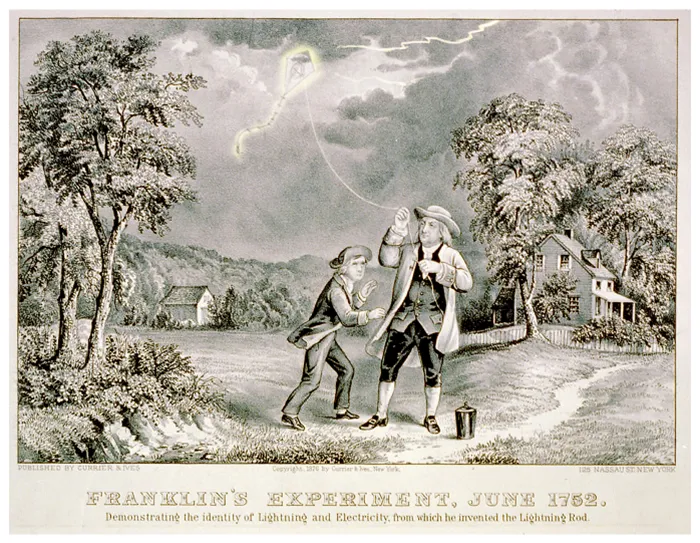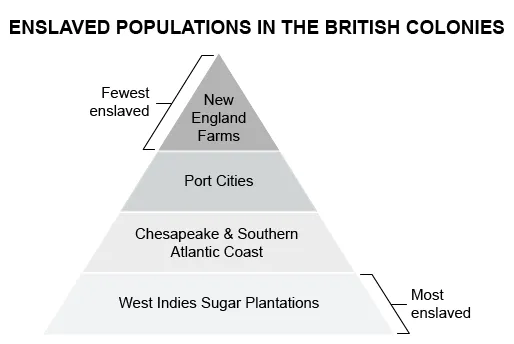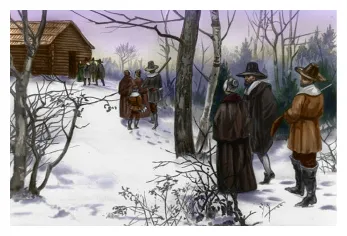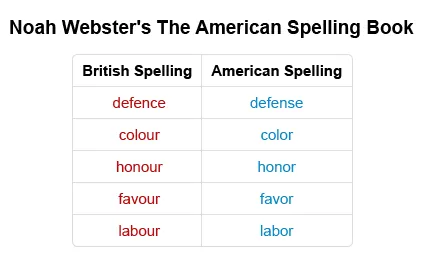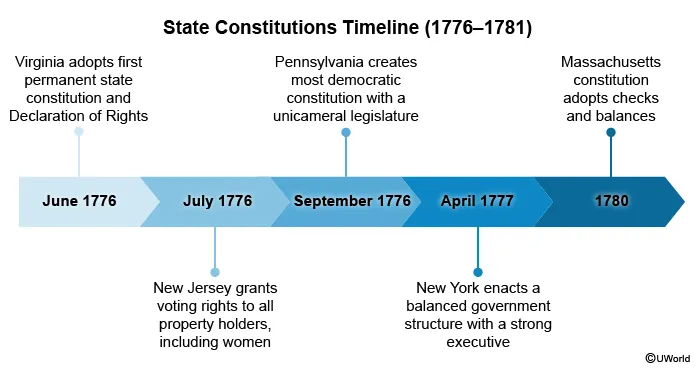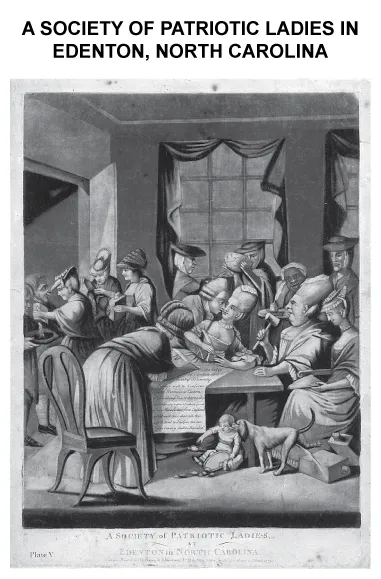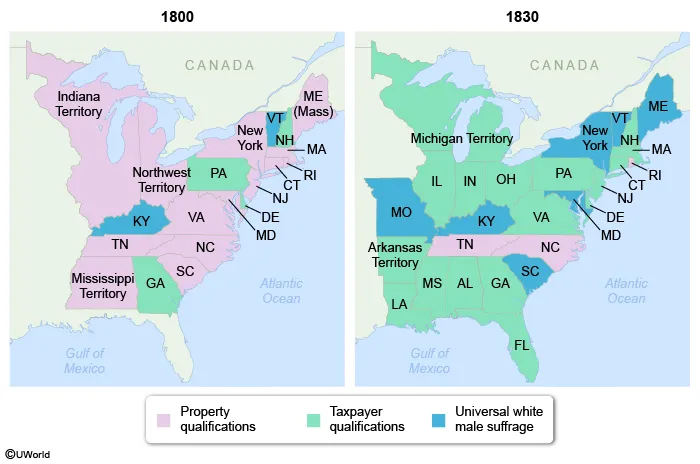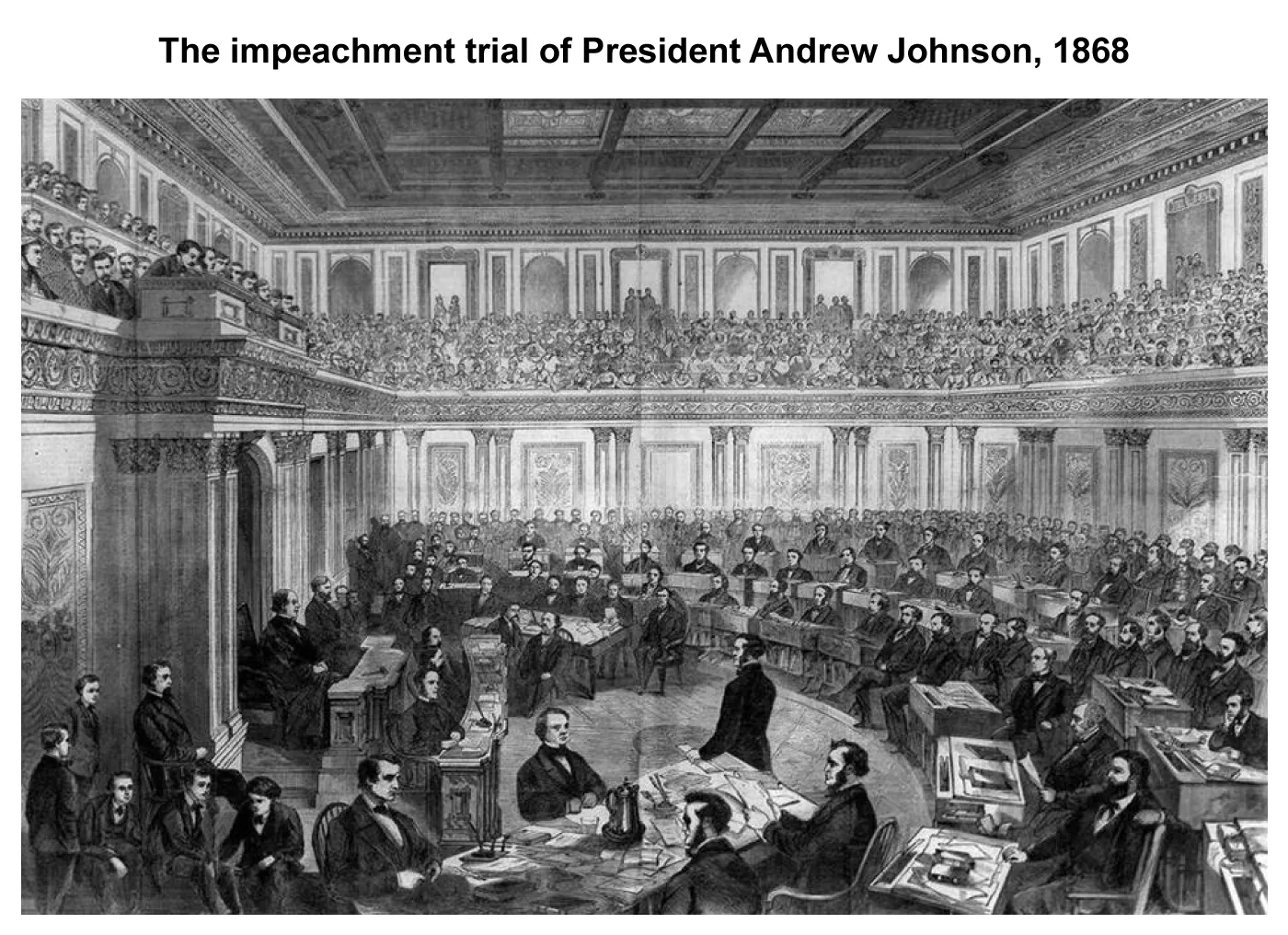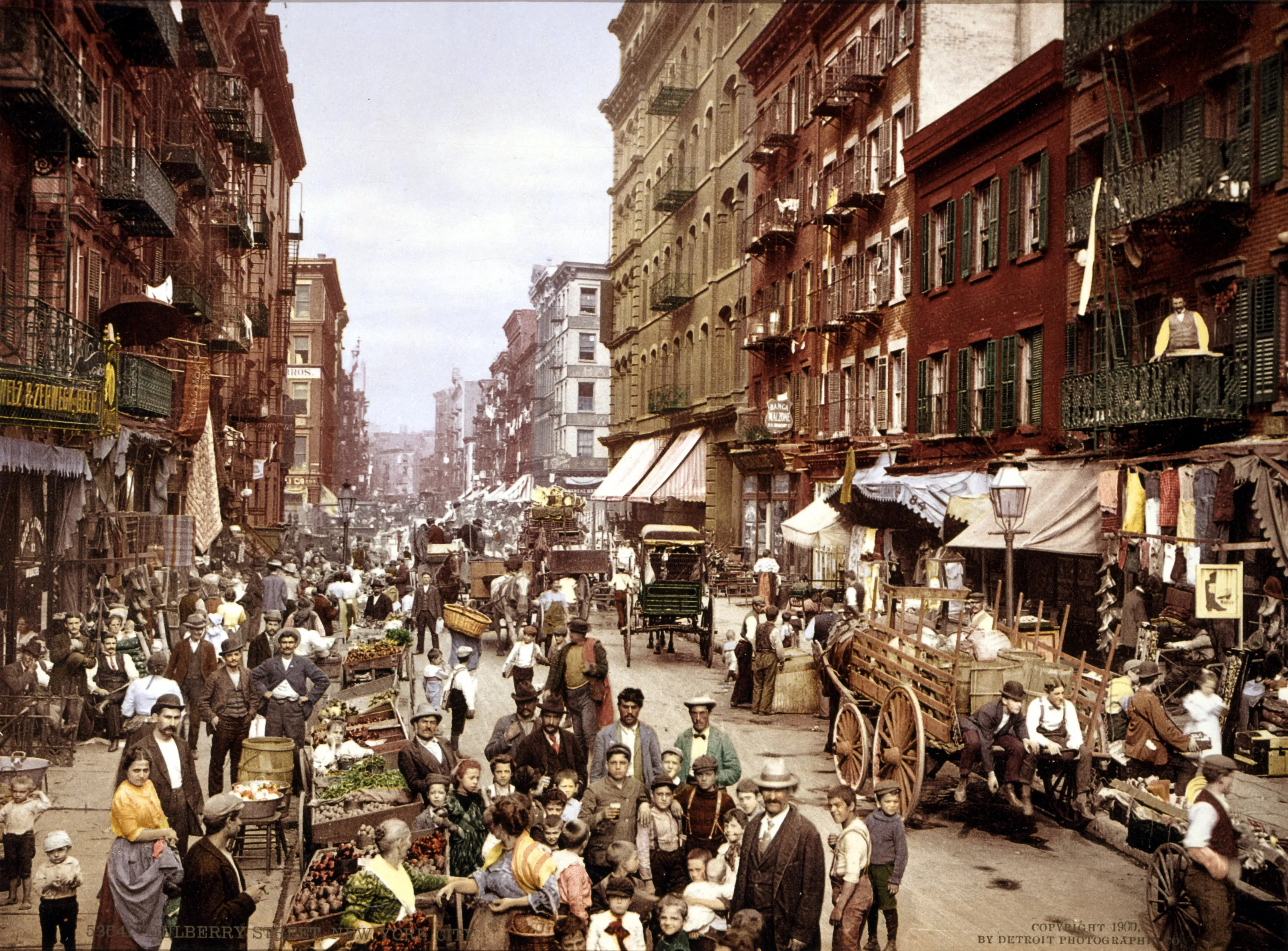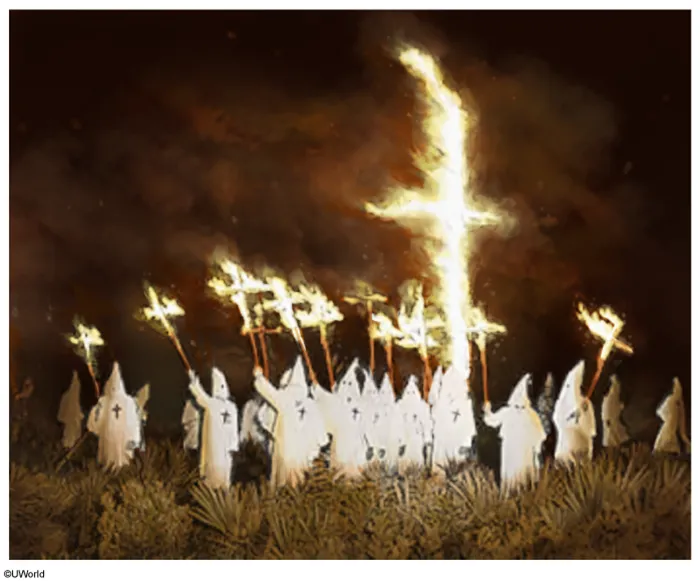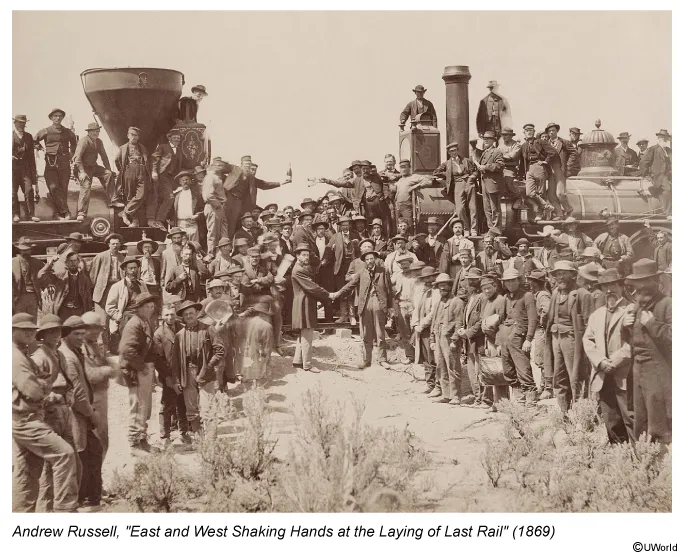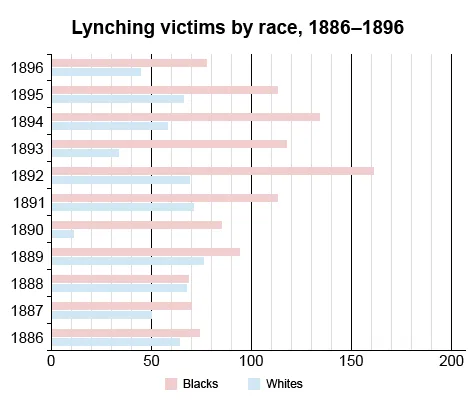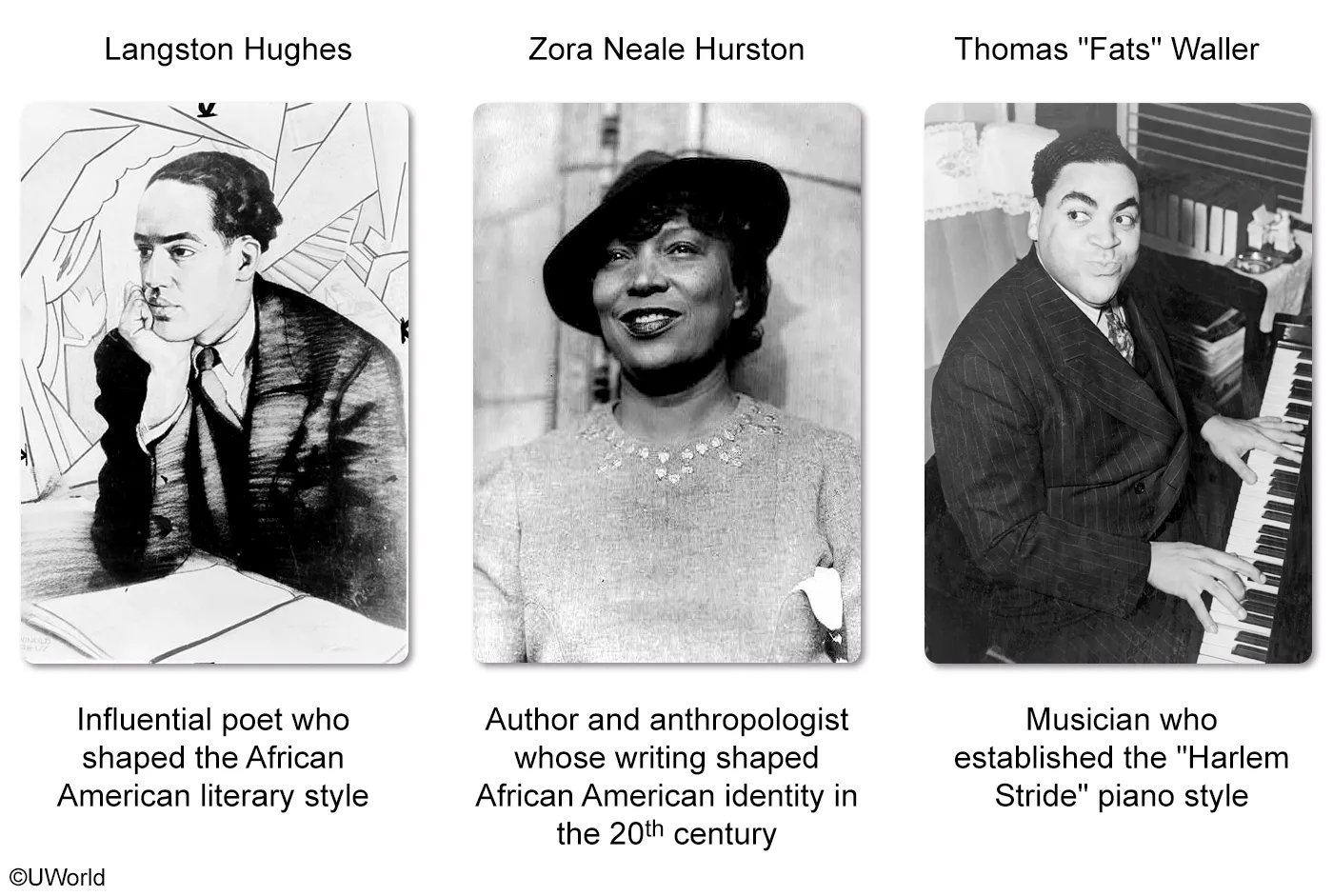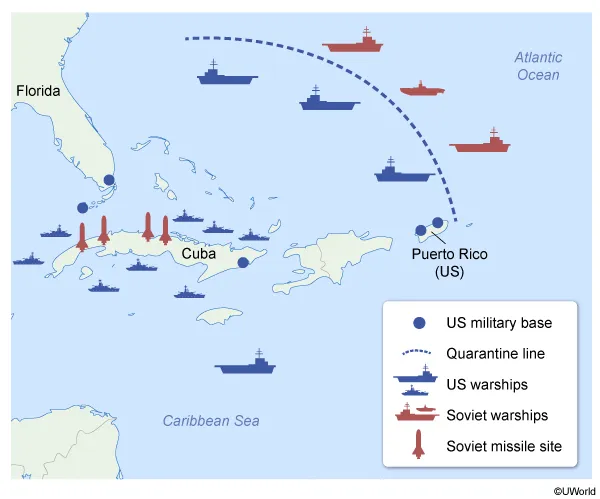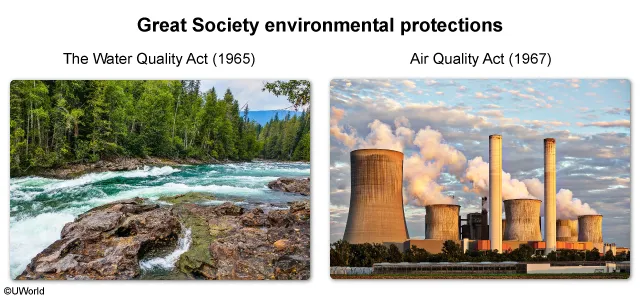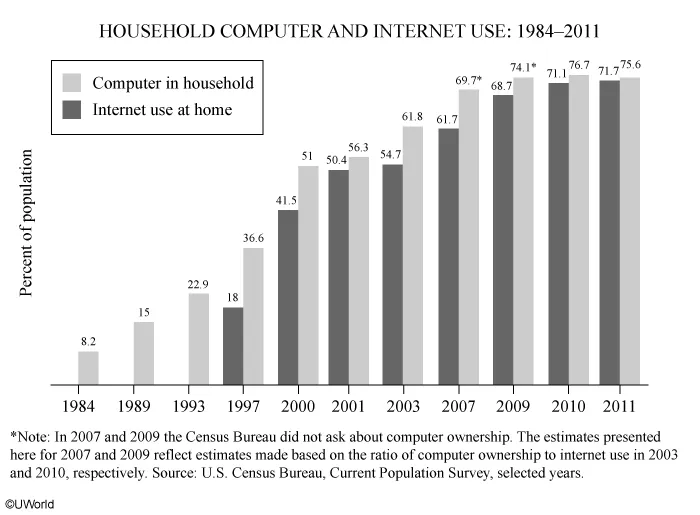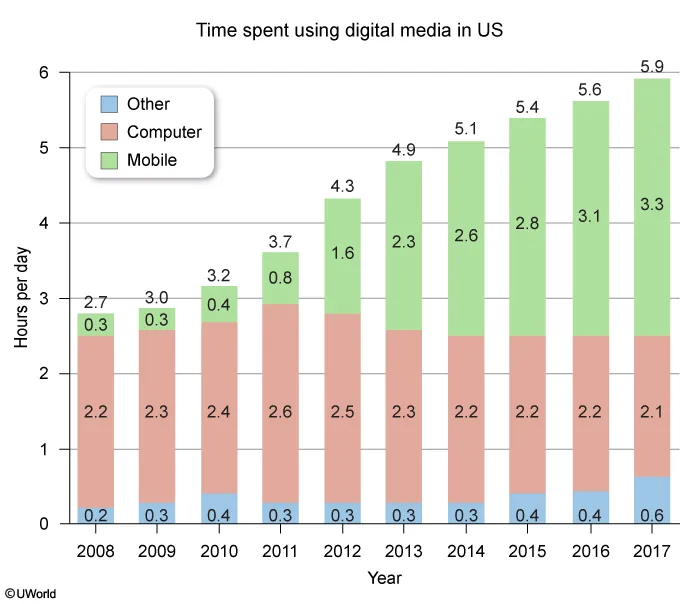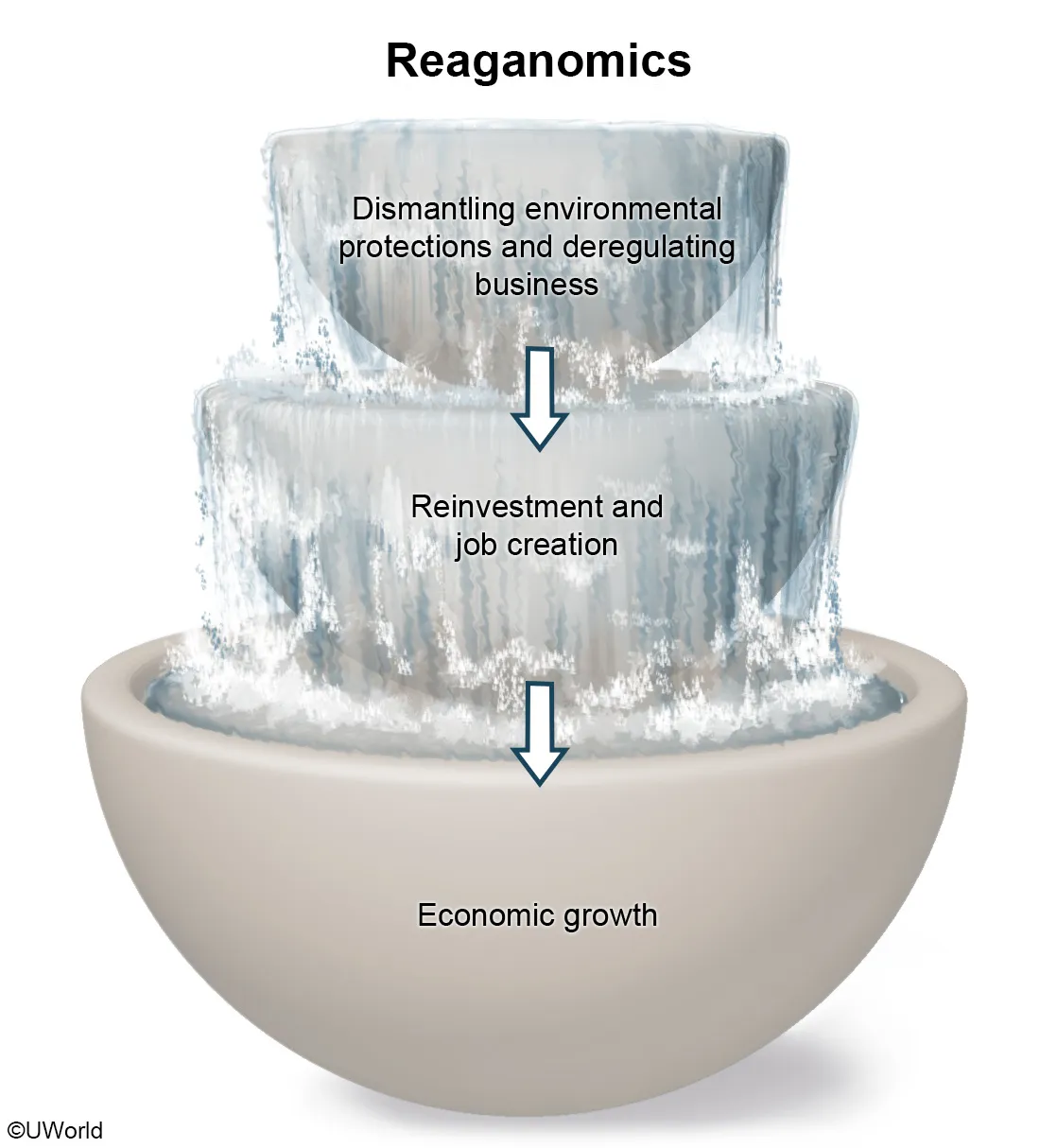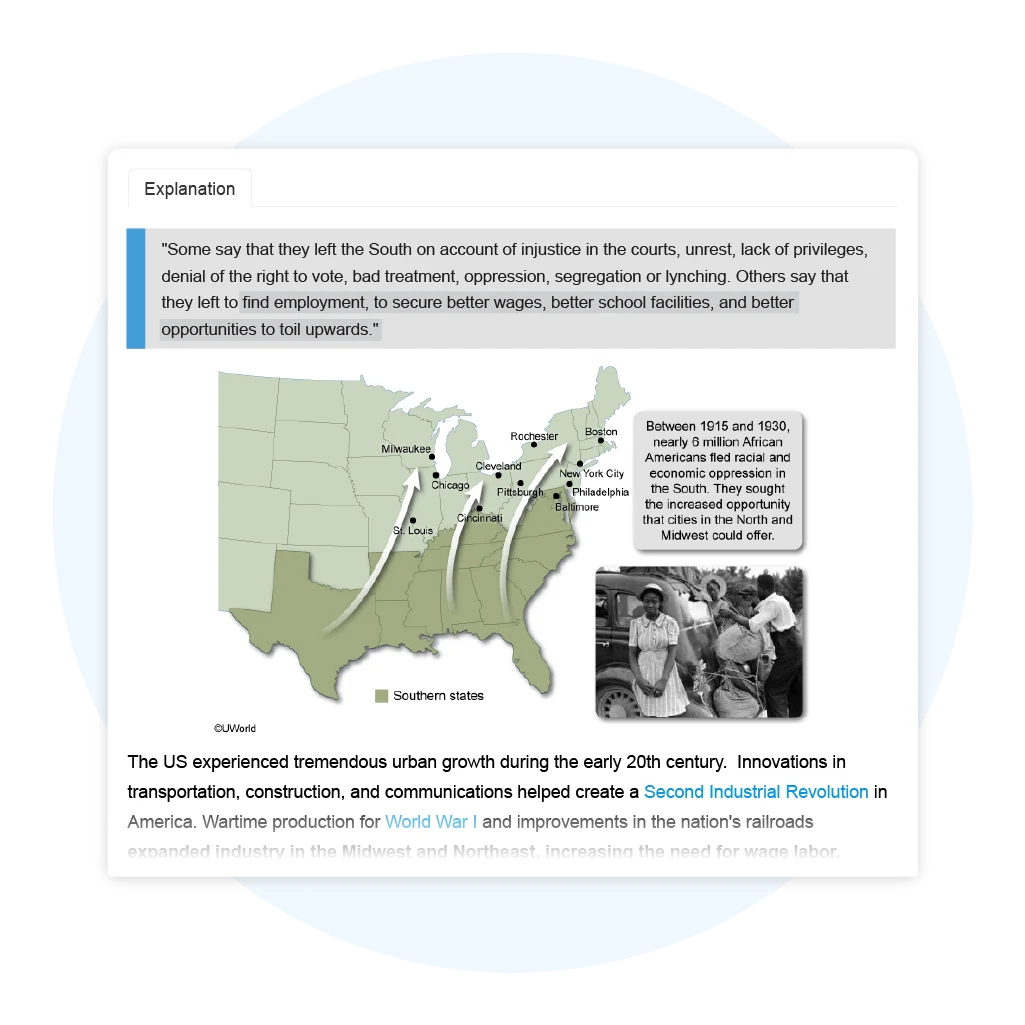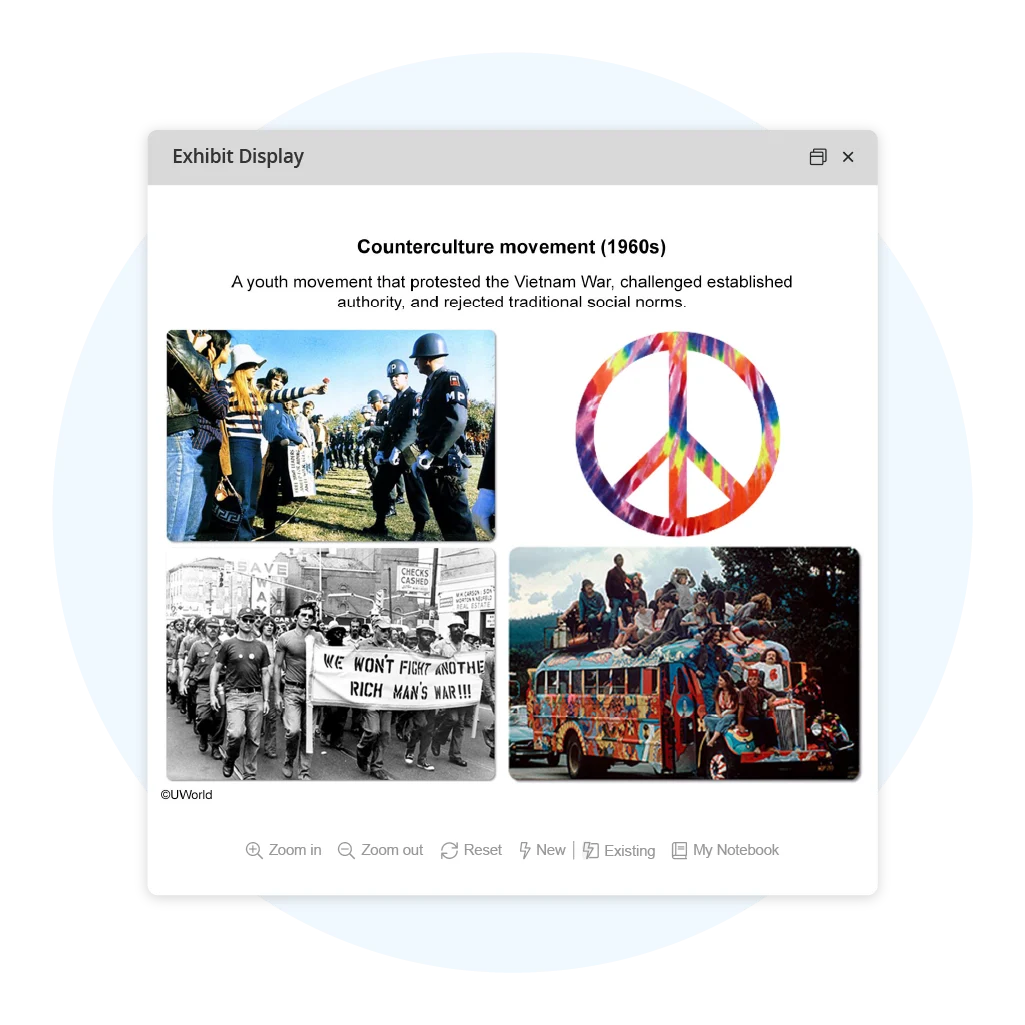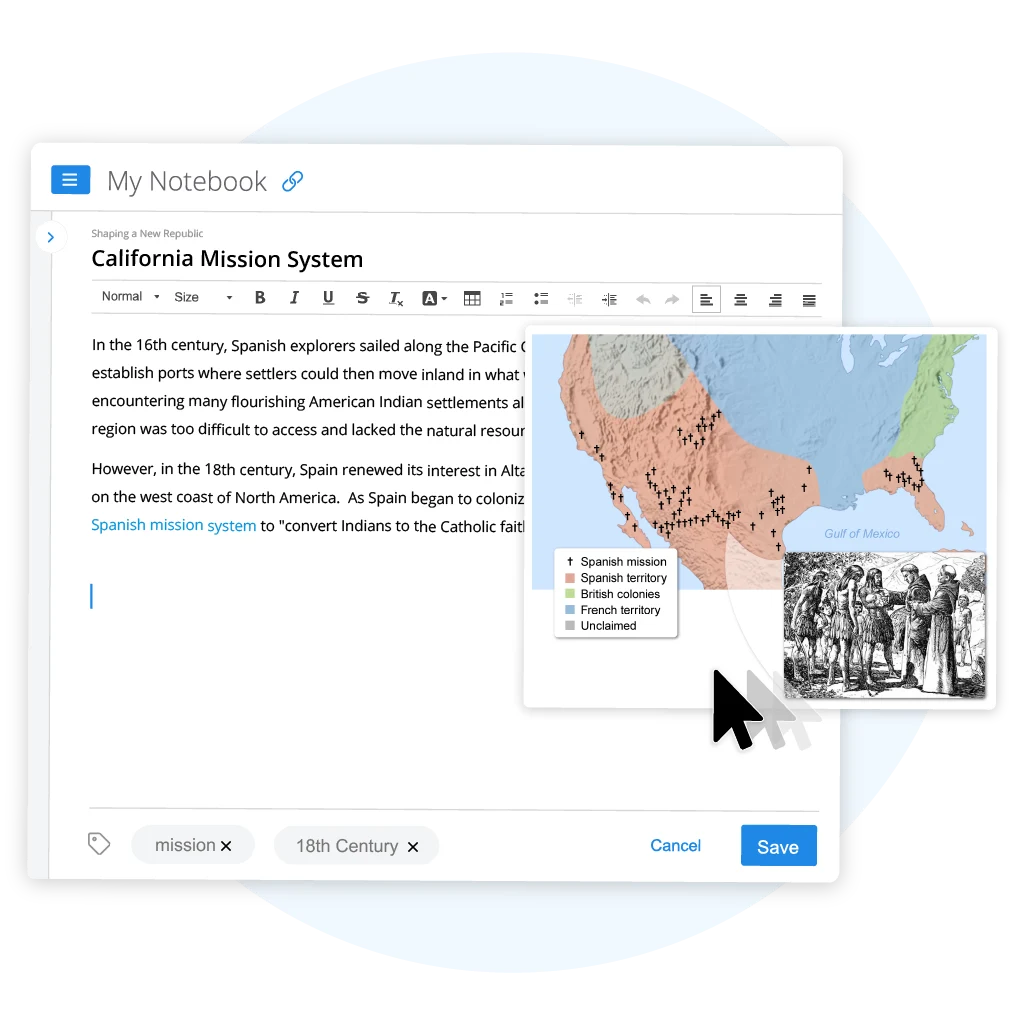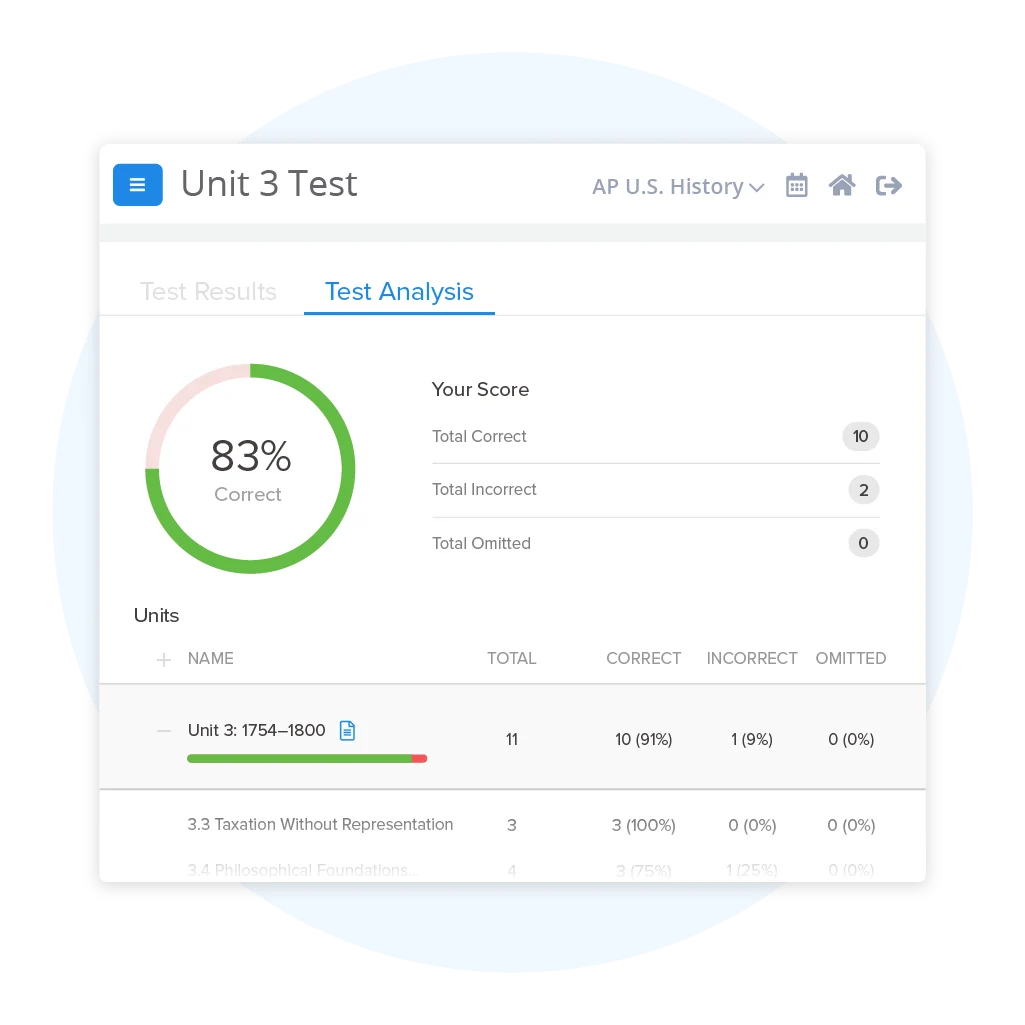APUSH Practice Test and Practice Questions
Prepare smarter. Master APUSH. Score higher with UWorld.
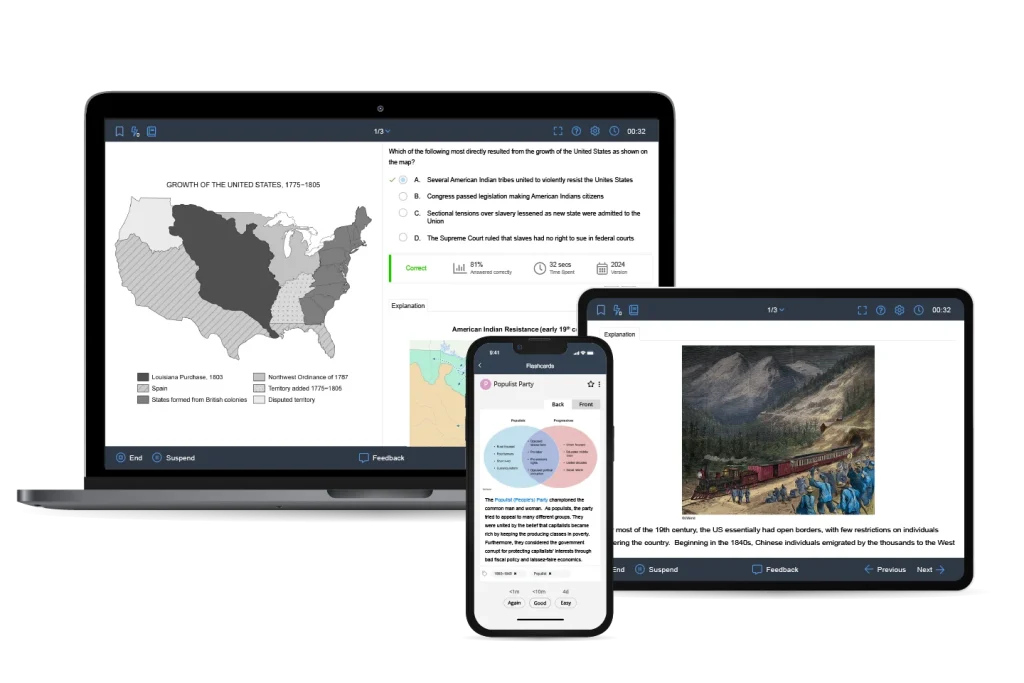
Try These AP U.S. History Practice Test Questions
APUSH Practice Test: 1491–1607
Passage:
Question
The settlement pattern of southeastern Native populations reflected in the map most directly resulted from
| A. the Indian slave trade | |
| B. foraging plants and harvesting marine resources | |
| C. the French and Indian War | |
| D. adoption of maize agriculture |
Explanation
Before maize agriculture spread to the Eastern Woodlands around 900 C.E., southeastern Native peoples weren't full-time agriculturalists—although they often tended small gardens of beans, sunflowers, and squash seasonally. Prior to 900 C.E., southeastern Native groups regularly moved their camps in order to hunt deer and gather wild foods. The adoption of Maize agriculture however, changed settlement patterns in the Eastern Woodlands.
Maize was grown throughout the year near major waterways on fertile flood plains; producing more food than populations consumed. Maize agriculturalists needed to stay close to their fields throughout the year, which meant villages were occupied year round. Populations exploded due to the surplus of food, providing more time, labor, and the motivation to construct and use ceremonial centers such as Moundville.
(Choice A) The Indian slave trade refers to the exportation of Natives by Europeans to the Atlantic World, and could not have affected prehistoric settlement patterns.
(Choice B) Foraging plants and harvesting marine resources are practices of hunters and gatherers. Large ceremonial centers, such as Moundville, are typically associated with maize agriculture in the New World.
(Choice C) The French and Indian War wasn't a prehistoric conflict; rather, it was a colonial conflict in which France and Britain fought for dominance of the continent.
Things to remember:
Once adopted, maize agriculture was very successful in the warm, wet climate and fertile soils of the Eastern Woodlands. Around 900 C.E., settlements shifted to areas near flood plains. Maize agriculture decreased the need for moving settlements during the year.
Passage:
Question
Which of the following was a key difference between the prehistoric peoples of the Great Basin and the Southeast?
| A. The Southeastern peoples were hunters and gatherers, and Great Basin cultures were agriculturalists | |
| B. Highly populated settlements dotted the Southeast, while Great Basin cultures were highly mobile and did not establish permanent settlements | |
| C. Great Basin cultures constructed permanent settlements on the shore of large lakes | |
| D. Introduction of the horse meant that Great Basin peoples hunted bison, the Southeastern peoples were maize agriculturalists |
Explanation
Archaeologists define prehistoric culture areas by geographic and cultural characteristics. The question asks for a comparison between two prehistoric culture areas: the Great Basin and the Southeast.
The table lists the contrasting characteristics of two culture areas.
| Great Basin | Southeast |
|
|
In contrast to the Mississippian chiefdoms of the Southeast, Great Basin peoples were highly mobile and did not establish permanent settlements.
(Choice A) Great Basin peoples were not agriculturalists, but rather highly nomadic (moved around). After 900 C.E., the prehistoric cultures of the Southeast were agricultural.
(Choice C) Although Great Basin culture settled on lakeshores during part of the year, these were not permanent settlements.
(Choice D) After the introduction of the horse to North America in the 1500s, the Plains Indians, not the peoples in the Southeast or the Great Basin, regularly hunted bison (buffalo) from horseback.
Things to remember:
Great Basin native people were highly mobile hunters and gatherers, whereas the peoples of the Eastern Woodlands were typically maize agriculturalists who established permanent settlements.
Passage:
Question
Which of the following cultural and social shifts resulted most directly from the adoption of maize agriculture by the native peoples of the Eastern Woodlands?
| A. A sharp increase in social inequality | |
| B. The emergence of a numerical system used to record transactions | |
| C. A decline in the political significance of clans and lineages | |
| D. A decline in the importance of the bow and arrow |
Explanation
The shift to maize agriculture changed more than settlement patterns; it also significantly changed society.
- Population increased significantly.
- Specialized jobs such as priests, artists, merchants, or rulers emerged.
Highly populated settlements required a system of order, which meant leadership. The most significant consequence of the shift to maize agriculture was that it made society hierarchical. A rigid social hierarchy—where almost all people live their entire lives in the social position they are born into—resulted in a sharp increase in social inequality.
(Choice B) Presently, there isn’t evidence that the maize agriculturalists of the Eastern Woodlands had a numerical system.
(Choice C) The political significance of clans and lineages increased after the adoption of maize agriculture. Clans and lineages were ranked; with the highest ranking producing an aristocracy and chiefs.
(Choice D) The bow and arrow, invented around 700 C.E. in North America, actually increased in importance after the adoption of maize. It made hunting more efficient and significantly changed warfare—which also increased after the adoption of maize agriculture.
Things to remember:
Maize agriculture drastically changed where and how prehistoric peoples of the Eastern Woodlands lived. Populations exploded and a social hierarchy developed.
APUSH Practice Test: 1607–1754
Passage:
"There were many grievances of which the Indians complained; but they had not the foresight to see the inevitable result of the constantly increasing power of the English…It was only when they felt the pressure of…persecution, that they began to think of opposition or revenge…[S]everal times the English had demanded that whole tribes should give up their arms because of the fault of one or a few…They were expert in the use of their guns and held them as the most precious of their possessions. The order to give these over to the English, with their stock of ammunition, was regarded by them as robbery…We can now see that from their standpoint there were grievances enough to drive them to rebellion."
George M. Bodge, Soldiers in King Philip's War, 1891
Question
Which of the following most shaped the events described in the excerpt?
| A. The methods of British land acquisition in North America | |
| B.The importance of the fur trade to Native American leaders for maintaining good relations with the British | |
| C. The decline of "praying towns" established by Puritans | |
| D. The number of Scots-Irish immigrants moving west of the Appalachians |
Explanation
In 1675, New England Puritan colonists numbered around 60,000, and there was a growing need for additional resources to accommodate the population. To acquire these resources, English settlers forced the Natives to sell their land in exchange for English goods that Natives had grown to depend on.
As the colonies expanded and their populations increased, Native Americans were forced to abide by English law. The colonists' quest for more resources, and the broader application of English law, slowly weakened the relationships between Puritans and Native Americans of the Eastern Woodlands.
Recognizing that the "constantly increasing power of the English" posed a threat to the Natives' survival, the Wampanoag leader Metacom, known to the English as King Philip, united several tribes and began to raid English towns throughout New England. Known as King Philip's War, the conflict lasted over a year and resulted in the deaths of thousands of colonists and Natives.
(Choice B) Although Native leaders used the fur trade for maintaining good relations with the English, the fur trade in New England declined as Puritan settlers continued to acquire Native land.
(Choice C) Puritan "praying towns" weren't on the decline prior to King Philip's War.
(Choice D) The Scots-Irish didn't begin arriving in the New World colonies in large numbers until 1717. Therefore, their eventual settlement west of the Appalachians couldn't shape the events of King Philip's War in 1675.
Things to remember:
As the population of New England continued to grow, colonists sought out Native-controlled land to accommodate this population growth, resulting in King Philip's War.
Passage:
"Make a small cross of two light strips of cedar, the arms so long as to reach to the four corners of a large, thin silk handkerchief when extended; tie the corners of the handkerchief to the extremities of the cross, so you have the body of a kite; which being properly accommodated with a tail, loop, and string, will rise in the air, like those made of paper; but this being of silk, is fitter to bear the wet and wind of a thunder-gust without tearing. To the top of the upright stick of the cross is to be fixed a very sharp-pointed wire, rising a foot or more above the wood. To the end of the twine, next the hand, is to be tied a silk ribbon, and where the silk and twine join, a key may be fastened."
This kite is to be raised when a thunder-gust appears to be coming on, and the person who holds the string must stand within a door or window, or under some cover, so that the silk ribbon may not be wet…. As soon as any of the thunder clouds come over the kite, the pointed wire will draw the electric fire from them, and the kite, with all the twine will be electrified….
At this key the phial may be charged; and from electric fire thus obtained…all the electric experiments [may] be performed…thereby the sameness of the electric matter with that of lightning [may be] completely demonstrated."
The Autobiography of Benjamin Franklin, 1791
Question
The ideas expressed in the excerpt are most closely aligned with which of the following broader historical developments?
| A. The establishment of the first colleges in New England | |
| B. The spread of Enlightenment thought from Europe to the colonies | |
| C. The tightening of British authority in New England | |
| D. The hysteria over suspected witchcraft in Puritan communities |
Explanation
Before the 18th century, most people relied on religion and superstition to explain the world around them. By the mid-1700s, however, Enlightenment ideas were circulating, suggesting that the world could be understood and improved by reason and logic.
The spread of Enlightenment thought to the American colonies fostered intellectual exchanges among educated colonists about government, philosophy, and science. Prominent figures, such as Benjamin Franklin, hosted informal gatherings called social clubs or salons where ideas were shared and debated. A leader of the American Enlightenment, Franklin promoted the idea that natural phenomena could be explained and harnessed through reason.
By emphasizing observation, scientific inquiry, and reason, Franklin's experiments with electricity exemplified the spread of Enlightenment thought to the colonies. His famous kite experiment demonstrated that lightning is a form of electricity, challenging superstition and promoting a rational understanding of natural phenomena.
(Choice A) The first colleges in New England were established to train Protestant ministers and did not embrace the excerpt's emphasis on scientific rationalism.
(Choice C) Franklin's experiments dealt with rationalism and scientific phenomena, not with the political attempt to tighten British authority in the Dominion of New England during the late 1600s.
(Choice D) Superstitions and religious ideas led to Puritan hysteria over perceived witches during the late 1600s, whereas the excerpt emphasizes scientific rationalism.
Things to remember:
By emphasizing reason, observation, and scientific inquiry, Benjamin Franklin's experiments with electricity exemplified the spread of Enlightenment thought to the American colonies.
Passage:
Question
Which of the following best explains the reason for the comparatively few enslaved people working on New England farms as shown in the image?
| A. British ships avoided sailing north toward New England and favored ports in the Southern colonies | |
| B. Sermons condemning enslavement gained popular appeal in the region due to the excitement around the First Great Awakening | |
| C. Mass migration of families to New England meant that farm labor was sufficient to support the needs of Puritan communities | |
| D. Puritanism discouraged enslavement to keep its practitioners in divine favor |
Explanation
Colonial New England farms were primarily established by Puritan settlers who migrated to America for religious, rather than economic, reasons. Unlike in the Southern colonies, where cash crops created a high demand for labor, New England agriculture was based on subsistence and small-scale farming. The region's harsh climate and rocky soil made large-scale plantation agriculture challenging.
Despite these limitations, New England farms thrived. Unlike the adventurers who settled the Chesapeake, New England settlers represented a cross-section of English society, including experienced farmers. These farmers, with Native help, adapted their techniques to the new environment. Because their goal was to feed their communities rather than to profit from agricultural exports, New England farms required less labor than Southern plantations.
Therefore, New England farms had the fewest enslaved laborers because the mass migration of Puritan families to the region provided sufficient labor to support the needs of their communities.
(Choice A) British ships did not avoid New England's seaports, which were hubs of trans-Atlantic commerce.
(Choices B and D) Neither sermons from the First Great Awakening nor Puritanism led New Englanders to discourage the institution of slavery.
Things to remember:
New England farms focused on subsistence and small-scale agriculture. The region's many Puritan families provided sufficient labor for these farms, thereby creating little need for enslaved laborers.
APUSH Practice Test: 1754–1800
Passage:
"The American Spelling Book…when first published, encountered an opposition, which few new publications have sustained with success. It however maintained its ground, and its reputation has been gradually extended and established, until it has become the principal elementary book in the United States.
In a great part of the northern States, it is the only book of the kind used; it is much used in the middle and southern States; and its annual sales indicate a large and increasing demand. Its merit is evinced not only by this general use, but by a remarkable fact, that…attempts made to rival it…have most…illegally copied a considerable part of the tables, with little or no alteration; and others have altered them, by additions, mutilations and subdivisions, numerous and perplexing. In most instances, this species of injustice has been discountenanced by the citizens of the United States, and the public sentiment has protected the original work, more effectually than the penalties…."
Preface to Noah Webster's The American Spelling Book, 1806 edition
Question
Which of the following best describes the primary purpose of the document from which the excerpt was taken?
| A. Promoting a distinctive national culture | |
| B.Increasing national literacy rates | |
| C. Advocating for the abolition of slavery | |
| D. Establishing a national public education system |
Explanation
Written for American classrooms during the post-Revolutionary era, Noah Webster's The American Spelling Book introduced new spellings for common English words. As the excerpt notes, by 1806, Webster's speller had "become the principal elementary book" in the nation.
Following the Revolution, many prominent Americans, including Webster, wanted to replace British cultural elements with those reflecting a uniquely American identity. He hoped his new spellings would easily distinguish American texts and writings from British ones. For example, certain words ending in "-ce," such as "defence," were changed to "-se," as in "defense." Similarly, the "u" was removed from words such as "color" and "labor."
The primary purpose of The American Spelling Book was to promote a distinct national culture, which many believed was crucial to solidifying American independence and differentiating themselves from the citizens of Great Britain.
(Choice B and D) Although The American Spelling Book was designed for elementary education, Webster's primary goal was not to improve literacy or establish a national education system, but to create a distinctly American version of the English language.
(Choice C) There was increased support for abolition following independence, but it was not related to The American Spelling Book.
Things to remember:
Following independence, Americans looked to replace many British cultural elements with those that reflected a uniquely American identity.
Passage:
"Whereas all the constitutional authority, ever possessed by the kings of Great Britain over these colonies, or their other dominions, was, by compact, derived from the people, and held of them for the common interest of the whole society, allegiance and protection are, in the nature of things, reciprocal ties, each equally depending upon the other, and liable to be dissolved by the other's being refused or withdrawn.
[A]ll inhabitants of this colony of full age, who are worth fifty pounds proclamation money clear estate in the same, and have resided within the county in which they claim a vote for twelve months immediately preceding the election, shall be entitled to vote for representatives in council and assembly; and also for all other public officers that shall be elected by the people of the county at large."
New Jersey State Constitution, 1776
Question
The excerpt best reflects which of the following?
| A. Conflicts over how to define citizenship | |
| B. Fear of unchecked democracy by the unpropertied classes | |
| C. Disagreement over the role of a centralized authority | |
| D. Creation of state governments based on natural rights of citizens |
Explanation
During the American Revolution, the thirteen colonies, having become independent states, experimented with various forms of governance in their constitutions. These documents empowered their legislatures, limited executive powers, and replaced royally appointed governors with elected officials. All state constitutions, including New Jersey's, reflected Enlightenment ideals of natural rights.
For example, New Jersey's constitution declares that "[A]ll the constitutional authority…was, by compact, derived from the people…[and] all inhabitants," rejecting the divine right of European monarchs and embracing the ideas of citizens' natural rights, notably, the ideas of John Locke.
Locke argued that all individuals possess inalienable, God-given rights to life, liberty, and property. The purpose of government, in Locke's view, was to protect those rights.
(Choice A) The excerpt does not reflect conflicts over unchecked democracy; rather, it discusses voting qualifications and emphasizes the idea that legitimate authority is derived from the people.
(Choice B) Although the excerpt includes a property requirement for voting, it does not express fear of lower-class political participation.
(Choice C) New Jersey's state constitution defined who had political held legitimacy; it did not include information about a disagreement about the role of a centralized authority in the federal government.
Things to remember:
State constitutions such as New Jersey's reflected Enlightenment ideas by grounding government in the natural rights of the people and popular consent rather than monarchic authority.
Question
The efforts depicted in the political cartoon emerged most directly from the context of which of the following?
| A. Calls to appease imperial authorities in the colonies | |
| B. Southern planters' desire for British luxury goods | |
| C. Challenges by poor farmers to the authority of elite planters | |
| D. Colonial resistance to new forms of British taxation |
Explanation
In response to new taxes, such as the Tea Act and the Intolerable Acts, colonists organized boycotts of British goods. To weaken British economic interests, the First Continental Congress endorsed a widespread boycott, encouraging colonists to use locally produced goods. These actions united the colonies against British oppression, fostering a shared American identity and purpose.
Boycotts were critical forms of resistance to British taxation and authority. The 1775 cartoon emerged from a reaction to colonial boycotts associated with the American Revolution. Although the portrayal of the colonial women is satirical, intended to ridicule them for stepping outside their traditional roles, the cartoon reflects colonial efforts to replace British imports with local goods as a form of protest.
(Choice A) Colonial boycotts reflected resistance, not appeasement, to imperial authorities.
(Choice B) The efforts depicted colonists avoiding the purchase of British goods as a means of resistance; the image did not indicate a desire for British luxury goods.
(Choice C) The efforts challenged the British Parliament's authority, not that of elite planters.
Things to remember:
Leading up to the American Revolution, women's participation in boycotts served as a critical form of resistance against British taxation and authority.
APUSH Practice Test: 1800-1848
Passage:
"Humanity has often wept over the fate of the aborigines of this country and philanthropy has long been busily employed in devising means to avert it, but its progress has never for a moment been arrested, and one by one have many powerful tribes disappeared from the earth….But true philanthropy reconciles the mind to these vicissitudes as it does to the extinction of one generation to make room for another….Philanthropy could not wish to see this continent restored to the condition in which it was found by our forefathers. What good man would prefer a country covered with forests and ranged by a few thousand savages to our extensive Republic, studded with cities, towns, and prosperous farms, embellished with all the improvements which art can devise or industry execute, occupied by more than 12,000,000 happy people, and filled with all the blessings of liberty, civilization, and religion?"
Andrew Jackson's Second Annual Message to Congress, 1830
Question
The excerpt most directly reflects which of the following developments in the United States during the first half of the nineteenth century?
| A. The Indian Removal Act | |
| B.The success of the Texas Revolution | |
| C. The ban on the importation of African slaves | |
| D. The end of the War of 1812 |
Explanation
"Humanity has often wept over the fate of the aborigines…and one by one have many powerful tribes disappeared from the earth…What good man would prefer a country covered with forests and ranged by a few thousand savages to our extensive Republic, studded with cities, towns, and prosperous farms, embellished with all the improvements which…industry [can] execute, occupied by more than 12,000,000 happy people, and filled with all the blessings of liberty, civilization, and religion?"
Andrew Jackson's Second Annual Message to Congress
To understand the excerpt, determine the following:
| When: | Who: | Why: |
| The title "Andrew Jackson's Second Annual Message to Congress" specifies the second year of Jackson's presidency—1830. | References to "aborigines," "powerful tribes," and "savages" indicate that Jackson's subject is American Indians. | According to Jackson, removal of the American Indians from their land is justified because expansion of American settlements ensures the nation's continued prosperity. |
The U.S. government had been slowly annexing (taking over) lands of Native American tribes since the 1780s, but the Indian Removal Act (1830) increased the seizure of lands east of the Mississippi River. The Act began the forcible relocation of tribes to Indian Territory, in present-day Oklahoma.
In 1838, the federal government evicted over 15,000 Cherokees from their homes and marched men, women, and children several hundred miles across mountainous terrain to Indian Territory. Known as the Trail of Tears, nearly 4,000 Cherokee perished during the journey due to hypothermia and exhaustion.
(Choice B) The Texas Revolution occurred in 1836, and this development isn't reflected in Jackson's 1830 address.
(Choice C) Congress banned the international slave trade in 1808, but this isn't directly related to Indian removal.
(Choice D) As a general, Andrew Jackson was considered a hero of the War of 1812; contributing to his victory in the presidential election of 1828. However, President Jackson's address to Congress in 1830 concerned the justification for the Indian Removal Act.
Things to remember:
As president, Andrew Jackson promoted the Indian Removal Act of 1830, the forced removal of American Indians living east of the Mississippi River.
Passage:
Where lieth woman's sphere?—Not there
Where strife and fierce contentions are,
Not in the wild and angry crowd,
Mid threat'nings high and clamors loud;
Nor in the halls of rude debate
And legislation, is her seat.
What then is woman's sphere? The sweet
And quiet precincts of her home:
Home!—where the blest affections meet,
Where strife and hatred may not come:
Home!—sweetest word in mother-tongue,
Long since in verse undying sung!
L. J. Cist, The Women's Sphere, 1845
Question
In the late 1840s, the sentiments described in the poem would be most challenged by
| A. Can effort by social reformers to limit alcohol consumption | |
| B. the spread of religious revivals during the Second Great Awakening | |
| C. the growing support among middle-class women for slavery's abolition | |
| D. the calls for women's suffrage by the Seneca Falls Convention |
Explanation
The Declaration of Sentiments, presented at the Seneca Falls Convention, raised concerns about gender inequality, including issues related to property rights, education, and legal status. Although the convention addressed a wide range of reforms, Elizabeth Cady Stanton's controversial call for women's suffrage most directly challenged the separate spheres ideology reflected in the poem.
Although many women were active in antebellum reform movements, suffrage placed women in the political sphere, traditionally reserved for men. Stanton's calls for suffrage challenged the period's gender roles by demanding a political voice, something many contemporaries viewed as incompatible with women's domestic responsibilities.
(Choices A and C) Antebellum reform movements, such as temperance and abolition, aligned with the cult of domesticity because they were seen as a natural extension of women's role in protecting the home.
(Choice B) The Second Great Awakening supported the ideals in the poem, often reinforcing traditional gender roles by encouraging women to fulfill their moral duties within the family.
Things to remember:
Elizabeth Cady Stanton's call for suffrage during the Seneca Falls Convention challenged the cult of domesticity's insistence that women would be confined to private life.
Passage:
Robert Cruikshank, "President's Levee, or All Creation going to the White House, Washington," 1841
1. "President's Levee, or All Creation going to the White House, Washington" by Robert Cruikshank, 1841
Question
Which of the following developments could best be interpreted as reflecting the actions depicted in the image?
| A. The spread of nativism due to Irish immigration | |
| B. The passage of the Indian Removal Act | |
| C. The impact of universal White male suffrage | |
| D. The growing success of antebellum reform movements |
Explanation
The 1820s saw American politics become more participatory as most states eliminated property requirements for White male voters. Politicians often supported these changes both out of principle, or to gain or maintain power. These developments gave rise to a broader and more socially diverse class of White male voters, reflected in the image's depiction of a rowdy and informal political culture wherein citizens socialized and politicians actively courted potential supporters.
For example, the image depicts ordinary Americans crowding toward the White House to celebrate Andrew Jackson's 1829 inauguration. Jackson made direct appeals to these voters during the election of 1828, a sharp contrast with the Federalist period when open campaigning was considered undignified.
This shift reflects the impact of universal White male suffrage and a more performative style of American politics, one that prioritized a candidate's charisma and public image alongside ideological debate.
(Choice A) The image portrays White voters and local campaigning, which often included immigrant participants.
(Choice B) The image makes no reference to Native peoples or federal land policies.
(Choice D) The scene depicts election activity, often involving alcohol, rather than reform movements such as temperance or abolition.
Things to remember:
Universal White male suffrage expanded voter participation, encouraged informal campaign tactics, and created a more competitive, populist political culture.
APUSH Practice Test: 1844-1877
Passage:
Question
Which of the following groups would have been most likely to see the development shown in the image as desirable?
| A.Republicans who wanted to reorder Southern race relations | |
| B.Southern Democrats who lost political influence after the Civil War | |
| C. Chinese laborers building the transcontinental railroads | |
| D. Whites opposed to teaching newly emancipated Blacks to read |
Explanation
Radical Republicans, who had long advocated for abolition and equal rights, gained influence after the Civil War. They envisioned a fundamental racial reordering of the South, aiming to ensure free labor and protect equal political rights.
The rise of the Radical Republicans was fueled by opposition to President Johnson's Reconstruction policies, which sympathized with White Southerners and opposed political rights for freedmen. The South's adoption of restrictive Black Codes in 1865 and its ongoing racial violence further united moderate Republicans with more radical members against Johnson's approach.
Radical Republicans supported President Johnson's impeachment, believing his removal from office would end his persistent obstruction of their Reconstruction policies. They wanted to fundamentally transform Southern society and grant equal rights to formerly enslaved people.
(Choice B) Southern Democrats opposed impeachment because President Johnson championed states' rights and wanted leniency for the South.
(Choice C) The Johnson administration negotiated a treaty allowing Chinese immigration to the US, but it denied them political rights. Therefore, these laborers likely had neutral views of Johnson's impeachment.
(Choice D) Whites opposed to teaching newly emancipated Blacks to read would not likely support Johnson's impeachment, mainly because the president strongly opposed federal efforts to educate freedmen.
Things to remember:
The Radical Republicans gained influence largely due to opposition to President Johnson's Reconstruction policies, which favored White Southerners and denied political rights to freedmen.
Passage:
1. United States Census Bureau
Question
The pattern depicted in the graph in the mid-nineteenth century most directly resulted in
| A. passage of the Alien and Sedition Acts | |
| B. a federal ban on immigration from Asia | |
| C. a more inclusive system of public welfare | |
| D. the growth of ethnically diverse cities in the Northeast |
Explanation
The influx of immigrants during the mid-19th century resulted in ethnically diverse cities. Large cities became crowded with immigrants and bustling with street life. Each ethnicity established neighborhoods, which provided a sense of community and helped ease the transition for newcomers. Immigrants brought their own customs, religions, foods, and languages.
As immigrants poured into the United States, many found low-paying wage jobs in large, industrialized cities of the Northeast. Despite the low pay, wage labor allowed families fleeing starvation conditions in their home countries to quickly acquire food and shelter in the United States. Immigrant neighborhoods were typically very poor, and the struggles of immigrants were often ignored by wealthier American city dwellers.
(Choice A) The Alien and Sedition Acts were an 18th century Federalist design to deny Thomas Jefferson the political support of those not born on U.S. soil, and weren't a result of the trend in the graph.
(Choice B) In the mid-19th century, Asians were a small percentage of immigrants. By the 1880s, however, nativist backlash against Asian immigrants targeted Chinese laborers.
(Choice C) Public welfare (economic assistance given by government) was extremely rare until the early 20th century, and the expansion of public welfare was not a direct result of the immigration trend seen in the graph.
Things to remember:
Immigrants crowded urban areas of the Northeast during the nineteenth century. The result was ethnically diverse cities.
Passage:
"By the proposed Amendment the right to vote will be secured to every citizen and will not depend on the will of the States…. This right should be lasting as the Constitution itself. Every type of man who is a citizen of the United States is presumed to be capable of self-government…. The gift of freedom to the colored race would be worse than worthless if not accepted by the right to vote."
William Holden, governor of North Carolina, 1869
Question
Which of the following was the most immediate result of the passage of the amendment referenced in the excerpt?
| A. Increased violence and intimidation against African Americans | |
| B. The increasing popularity of Radical Republicans among Southerners | |
| C. The decline of sharecropping as an economic system | |
| D. The desegregation of public accommodations throughout the United States |
Explanation
After the Civil War, the 13th Amendment freed nearly 4 million slaves in the South. For many African Americans, the expectation was that the freedom the amendment granted would also convey the rights and privileges of US citizens to former slaves. However, following the end of slavery, Southern states began passing laws that restricted the rights of African Americans. Known as Black Codes, these laws kept African Americans from possessing the same rights as Whites, including the right to vote.
In response, the Republican-controlled Congress ratified the 15th Amendment, granting African American males the right to vote. Although supported by constitutional law, when African American males in the South began to exercise their right to vote, groups of Southerners started a campaign of violence and intimidation to keep African Americans from the polls.
In particular, the Ku Klux Klan (KKK) instituted a reign of terror that included lynching African Americans. The intimidation, designed to keep African Americans from voting, was so severe that the federal government passed the Force Acts in the early 1870s. These laws allowed the US military to arrest suspected KKK members and protect African American voters.
(Choice B) Radical Republicans were unpopular with Southerners because they pushed for racial equality.
(Choice C) Sharecropping increased dramatically during Reconstruction.
(Choice D) The desegregation of public accommodations in the US did not occur until Congress passed the Civil Rights Act of 1964.
Things to remember:
The 15th Amendment granted African Americans the right to vote. However, Southern groups such as the Ku Klux Klan used violence and intimidation to keep African Americans from the polls.
APUSH Practice Test: 1865–1898
Question
The completion of the first transcontinental railroad shown in the photograph most directly resulted from
| A.The end of Native American resistance | |
| B.The influx of Chinese immigrant laborers | |
| C. The emergence of an antitrust movement | |
| D. The enactment of the Interstate Commerce Act |
Explanation
For most of the 19th century, the US essentially had open borders, with few restrictions on individuals entering the country. Beginning in the 1840s, Chinese individuals emigrated by the thousands to the West Coast to mine gold. After the gold rush declined in the 1860s, Chinese laborers provided most of the unskilled labor for construction of the transcontinental railroad.
Building the transcontinental railroad was a massive undertaking that required thousands of workers. Well over 10,000 Chinese immigrants, predominantly unmarried men, filled the jobs and worked as contract laborers. Immigrants helped lay track across virgin wilderness, across the Great Plains, and through the mountains. This backbreaking, hazardous work took place 6 days a week, year-round.
(Choice A) Native American resistance to US expansion intensified, not ended, following completion of the first transcontinental railroad in 1869.
(Choice C) The antitrust movement called for breaking up trusts which created monopolies on certain industries, including railroads. This movement didn't aid the completion of the transcontinental railroad.
(Choice D) The Interstate Commerce Act regulated the railroad industry but didn't contribute to the completion of the first transcontinental railroad.
Things to remember:
In the mid-19th century, Chinese immigrants on the West Coast provided most of the unskilled labor for construction of the transcontinental railroad.
Passage:
"With the Negro…eliminated from all participation in…elections, there could be no longer an excuse for killing Negroes to prevent 'Negro Domination.' Brutality still continued…[and] the murderers invented the…excuse…that Negroes had to be killed to avenge their assaults upon [White] women.
If the Southern people…would…admit that colored men and women are lynched for almost any offense…there would not now be the necessity for this defense.
It [now] becomes a painful duty of the Negro to reproduce a record which shows that a large portion of the American people…condone murder and defy the contempt of civilization. We plead not for the colored people alone, but for all victims…. During the year 1894, there were…197 persons…put to death by mobs who gave the victims no opportunity to make a lawful defense. No comment need be made upon a condition of public sentiment responsible for such alarming results….
[T]he pages which follow shall be…the record…made, not by colored men, but…by white men, of reports sent over the civilized world by white men in the South….
[T]he Chicago Tribune…has made a specialty of the compilation of statistics touching upon lynching. The data compiled by that journal and published to the world January 1, 1894, up to the present time has not been disputed."
Ida B. Wells, The Red Record: Tabulated Statistics and Alleged Causes of Lynching in the United States, 1895
1. The Red Record: Tabulated Statistics and Alleged Causes of Lynching in the United States, 1895
Question
The type of views expressed in the excerpt emerged most directly from which of the following trends?
| A. Growing anti-Catholic sentiment | |
| B. Racial violence against African Americans | |
| C. The closing of the frontier | |
| D. Support for labor strikes |
Explanation
Lynching refers to the violent killing of individuals without a legal trial. Although some people have described lynching as a form of vigilante justice for alleged crimes, during the late 19th century it was primarily used against African Americans to uphold White dominance.
As Black communities began to thrive economically during the late 19th century, the number of African Americans lynched increased. Despite comprising less than 15 percent of the population, the number of African Americans that were lynched during the 1890s far exceeded that of Whites.
The excerpt is from Ida B. Wells' The Red Record—a detailed report on the 197 instances of lynching that occurred in 1894. Wells' work emerged from a trend of racial violence against Black communities and clearly shows that lynching disproportionately impacted African Americans.
(Choice A) Anti-Catholic sentiment typically affected European immigrants, whereas the views in the excerpt pertain to racial violence against Blacks.
(Choice C) The 1890 Census declared the frontier "closed" five years before Wells wrote The Red Record, but nothing in the excerpt emerged from that development.
(Choice D) Support for labor strikes is not related to the experience of racial violence discussed in the excerpt.
Things to remember:
During the late 19th century, lynching was a common type of racial violence primarily inflicted by Whites against Blacks.
Question
Which of the following groups would have been most likely to support the policy suggested in the image?
| A. Pro-immigration union leaders | |
| B. Southern cotton sharecroppers | |
| C. White working class | |
| D. Business owners and Christian missionaries |
Explanation
In order to answer this question, consider the following:
- What is the policy that the cartoon is referencing?
- Who would have supported this policy?
Policy: The 1882 cartoon, depicting a Chinese immigrant unable to enter the United States, is referencing the Chinese Exclusion Act of 1882. The Act banned Chinese laborers, skilled or unskilled, from entering the country for ten years, and also prevented any Chinese immigrant from becoming a citizen of the United States; however, Chinese immigrants who arrived before the Act and were not yet citizens were exempt.
Supporters: The white working class would have been most likely to support the Chinese Exclusion Act. Chinese laborers worked for extremely low wages, which employers preferred as it helped them earn a larger profit. The lower wages paid to the Chinese, in turn, had the effect of crowding out white laborers.
As a result, the most vocal opponents of Chinese labor and immigrants were white laborers, such as members of the Workingmen's Party of California, which opposed Chinese immigration.
(Choice A) Pro-immigrant union leaders would have opposed the Chinese Exclusion Act because they believed immigrants had a right to work in the United States.
(Choice B) Although some Chinese laborers were hired to work on sugar plantations in the South, there is little evidence to support the claim that southern sharecroppers supported the Chinese Exclusion Act.
(Choice D) A substantial number of business owners and missionaries opposed the Chinese Exclusion Act. Business owners profited from paying lower wages to Chinese laborers, and missionaries saw Chinese immigrants as potential converts to Christianity.
Things to remember:
The Chinese Exclusion Act of 1882 was supported by the white working class, who viewed the Chinese as taking away economic opportunities because the Chinese laborers were willing to work for less money.
APUSH Practice Test: 1890–1945
Passage:
Question
The graph most strongly supports which of the following arguments?
| A.The New Deal resulted in an expansion of the powers of the federal government and the president | |
| B.The Hoover administration's response to the Great Depression failed to stop the economic decline experienced by American families | |
| C. Direct intervention in the economy by the federal government resulted in opposition by conservatives on the Supreme Court | |
| D. The Great Depression reversed a long-standing migration trend in the United States as people moved from cities to rural areas |
Explanation
In March 1929, Herbert Hoover was sworn in as president during a period of economic optimism; seven months later the stock market collapsed. The severity of Black Tuesday set in motion a chain of events that sank the nation–and the world–into the Great Depression.
The graph shows a sharp, dramatic, three-year economic decline during the Hoover administration. During the Great Depression, President Hoover opposed direct government intervention in the economy and vetoed measures to provide federal assistance to families. Hoover felt voluntary action, such as the relief provided by private charities, was the best response.
The Hoover administration also passed the Hawley-Smoot Tariff, which increased taxes on imported goods and made them less affordable for American consumers. The Hoover administration's efforts to stimulate the economy included government bailouts for banks and railroads. As the graph illustrates, the administration's response in the Great Depression failed to stop the economic decline of American families.
(Choices A, C, & D) – All these choices are true of the Great Depression; however, the information in the graph does not support them.
(Choice A) The New Deal's expansion of federal government powers would be supported by data on the number of economic programs passed, not by data on the decline of personal wealth.
(Choice C) Supreme Court conservatives' opposition to federal economic intervention would be supported by data on the number of judicial rulings against the New Deal, not by the decline of personal wealth.
(Choice D) A reversal of the long-standing migration trend in the United States as people moved from cities to rural areas would be supported by demographic data, but not the economic data presented on the graph.
Things to remember:
The Hoover administration's response to the Great Depression failed to stop the sharp economic decline experienced during his presidency. Furthermore, Hoover's refusal to provide relief for families, and the passage of the Hawley-Smoot Tariff deepened the economic crisis.
Passage:
Question
Which of the following factors most directly contributed to the economic growth after 1938 shown in the graph?
| A.An expansion of the social welfare programs enacted by the New Deal | |
| B.A growing reluctance to stimulate the economy through New Deal job creation programs | |
| C. A fear of too much direct government intervention in the economy | |
| D. An increase in economic production to supply the war-time needs of European allies |
Explanation
Neither the Hoover administration nor the sweeping programs of the Franklin D. Roosevelt administration can be credited with ending the Great Depression. Rather, the unfortunate development of another global war emerging on the horizon benefited the US economy the most during by 1940.
Although the US was determined to not become involved in a second global conflict, by 1938 there was no denying that Europe was headed for this fate. America's European allies needed supplies to mobilize for World War II, and the US–whose idle factories were shielded from attack by geography–was in a favorable position to produce and sell needed goods to them.
In 1938, manufacturing jobs began coming back to US factories. As the US supplied the war effort for its allies, the economy began to expand. When the US finally entered World War II in 1941, the economy began to exceed the level it had reached immediately before the stock market crash of 1929.
(Choice A) After 1938, the Roosevelt administration had to fend off challenges to New Deal social programs. However, an increase in US manufacturing supplied Europe's war effort and started the economic recovery.
(Choice B) The stimulation of the economy through New Deal job creation programs such as the WPA was beneficial, however, America's economic recovery post-1938 was mostly the result of supplying the war-time needs of European allies.
(Choice D) After 1938, many conservatives feared the government had interfered too much in America's economy, but this was unrelated to the return of manufacturing jobs, which accounted for the sharp economic uptick during the period.
Things to remember:
After 1938, manufacturing for WWII began to grow the economy, first as the US supplied European allies and then as the country entered the war in 1941.
Passage:
"Within the last two years there has been a steady stream of Negroes into the North in such large numbers as to overshadow in its results all other movements of the kind in the United States. These Negroes have largely come from Alabama, Tennessee, Florida, Georgia, Virginia, North Carolina, Kentucky, South Carolina, Arkansas and Mississippi…. [W]e hear that…[they] are being brought North to fight organized labor, and to carry doubtful States for the Republicans....
Some say that they left the South on account of injustice in the courts, unrest, lack of privileges, denial of the right to vote, bad treatment, oppression, segregation or lynching. Others say that they left to find employment, to secure better wages, better school facilities, and better opportunities to toil upwards."
Carter G. Woodson, historian, A Century of Negro Migration, 1918
Question
The Great Migration described in the excerpt led most directly to which of the following?
| A.African American expressing identity through new forms of art and literature | |
| B. African Americans achieving racial equality in northern cities | |
| C.Labor shortages for factories in the South | |
| D. A decreasing emphasis on agriculture in the South |
Explanation
Between 1915 and 1930, millions of African Americans fled racial oppression in the South for cities in the Northeast and Midwest. This exodus, known as the Great Migration, was one of the largest internal mass migrations in US history.
Unwelcome in White neighborhoods in the North, African Americans self-segregated into neighborhoods such as Harlem in New York City and Chicago's South Side. As a result, these neighborhoods became centers of African American culture.
The Harlem Renaissance in the 1920s was a rebirth of African American intellectual and artistic expression. African American identity was expressed through new forms of art and literature. Writers such as Langston Hughes and Zora Neale Hurston shaped African American literary style. Harlem also produced innovative fashion and musical styles that reflected African American culture—for example, Thomas "Fats" Waller's "Harlem Stride" piano style.
(Choice B) Rather than tolerance, African American families migrating to northern cities found escalating racial tensions that sparked violence, such as the Chicago Race Riot of 1919.
(Choice C) The migration of Black labor to the North did not cause a labor shortage in Southern factories because the region was primarily agricultural with little industry.
(Choice D) Instead of diminishing in importance, agriculture remained a cornerstone of the South's economy throughout the early 20th century.
Things to remember:
During the early 20th century, mass migration of African Americans into northern cities led to what became known as the Harlem Renaissance, a celebration of African American intellectual and artistic expression.
APUSH Practice Test: 1945–1980
Passage:
"[Secretary of Defense] Mr. McNamara pointed out that if we are going to take overt military action, it must at all costs be done on a 100% basis and before any of the missiles become operational. General Taylor pointed out that…we should establish an immediate blockade and then look toward invasion although this latter prospect did not enthuse him…
The President pointed out that the missiles certainly had to be removed one way or another… In the meantime, there was much information to be gathered and much analysis to be done… He authorized as many U-2 flights as needed to get full, complete, 100% coverage of the island. He asked for a report on the latest analysis of just what the thinking toward Cuba is in Latin American countries, as well as NATO, as to any action the US might take..."
Lt. Gen. Marshall Carter, notes from cabinet meeting on October 15, 1962
Question
The potential "military action" suggested in the excerpt was most directly a response to the
| A.growth in the number of military shipments to Cuba | |
| B.consolidation of power by Fidel Castro's government | |
| C. efforts by the Soviet Union to blockade western Berlin | |
| D. government policy of removing nuclear missiles from Turkey and Italy |
Explanation
Prior to the failed, US-backed Bay of Pigs invasion in 1961, Cuba's relations with the Soviet Union (USSR) were based upon the USSR providing Cuba limited economic and military support. After the Bay of Pigs fiasco, however, Soviet-Cuban relations expanded considerably—particularly after the Cuban leader, Fidel Castro, announced he was a communist.
The Kennedy administration paid close attention to the growing Soviet-Cuban relationship, particularly after US surveillance reported Soviet ships delivering what appeared to be large volumes of military hardware to Cuba. Tensions increased as US spy planes detected nuclear missile sites on the island.
In response, the Kennedy administration planned for several contingencies, including the possibility of bombing Cuba to destroy the missile sites. Ultimately, Kennedy chose to use the US Navy to enforce a blockade of Cuba—heightening the Cuban missile crisis—to stop further shipments of missiles to Cuba from the Soviet Union.
(Choice B) By itself, Castro's consolidation of power did not warrant military action. Rather, the US response in 1962 was due to Soviet shipments of nuclear missiles to Cuba.
(Choice C) The Soviet blockade of Berlin was resolved in 1949 and the military action suggested in the excerpt was in response to Soviet military shipments to Cuba.
(Choice D) The removal of nuclear missiles from Turkey and Italy was a result of the Cuban missile crisis, not a cause of it.
Things to remember:
US surveillance reported an increased number of Soviet ships delivering what appeared to be missiles to Cuba. To stop further Soviet shipments, the US chose to enforce a blockade, escalating tensions during the Cuban missile crisis.
Passage:
"The Great Society…demands an end to poverty and racial injustice, to which we are totally committed in our time. But that is just the beginning.
Our society will never be great until our cities are great. Today the frontier of imagination and innovation is inside those cities and not beyond its borders…. It will be the task…to make the American city a place where future generations will come…to live the good life.
The second place we begin to build the Great Society is in our countryside…. The water we drink, the food we eat, the very air that we breathe, are threatened with pollution…. Green fields and dense forests are disappearing.
The third place to build the Great Society is in the classrooms of America…. Our society will not be great until every young mind is set free to scan the farthest reaches of thought and imagination."
President Lyndon B. Johnson, "Great Society Speech," 1964
Question
Great Society legislation resulted in
| A.a decrease in the power of the executive branch | |
| B.federal initiatives addressing environmental issues | |
| C. extensive dismantling of New Deal programs | |
| D. less federal protection for historical building and landmarks |
Explanation
In addition to waging a "War on Poverty," President Lyndon B. Johnson's (LBJ's) Great Society also focused on social issues such as public safety and health. LBJ felt government should work to improve the lives of its citizens—a central belief of 20th century liberalism. For LBJ, this included protecting the natural world in which Americans lived.
To reduce the pollution in America's water, the Water Quality Act (1965) established standards for water quality and authorized the Federal Pollution Control Administration to enforce regulations. The Act also included federal funding for state agencies.
To reduce air pollution, the Clean Air Act was strengthened, expanding the federal government's role in reducing pollution. The Motor Vehicle Air Pollution Act (1965) set standards for automobile emissions. In addition, the Air Quality Act (1967) increased environmental research and monitoring of air pollution along interstates.
(Choices A, C, and D) These choices represent opposites of notable results of the Great Society legislation, which included:
- Increasing the power of the executive branch.
- Expansion of New Deal programs, such as Social Security.
- Increasing federal protections for historic buildings and landmarks, such as with the National Historic Preservation Act of 1966.
Things to remember:
In the mid-1960s, Great Society legislation strengthened and expanded the federal government's role in reducing pollution and protecting the environment.
Passage:
Question
Which of the following movements expressed ideas most similar to the ideas expressed by the counterculture?
| A.Imperialism of the 1890s and 1900s | |
| B. Fundamentalism of the 1910s and 1920s | |
| C.Feminism in the late 1960s and 1970s | |
| D. Social conservatism of the 1980s and 1990s |
Explanation
Inspired by the Civil Rights Movement, countless young women joined the cause for social justice in the 1960s. Many joined organizations such as Students for a Democratic Society but found their roles confined to typical feminine roles, such as secretaries. This exclusion led a group of politically active women to begin a second wave of feminism that shared many similarities with the counterculture movement.
Like the counterculture movement, second-wave feminists rejected many of the social, economic, and political values of their parents' generation. For example, the counterculture's critique of mass culture was echoed in Betty Friedan's The Feminine Mystique. Freidan argued that housewives were trapped by a false promise of domestic happiness marketed to a consumer society, which became central to feminism in the 1960s and 1970s.
Other second-wave feminists, such as Gloria Steinem, helped establish the women's liberation movement. Like the counterculture, the movement challenged established power structures, championed gender freedom, and rejected traditional standards of beauty.
(Choice A) US imperialism sought to spread American culture across the globe and had little in common with the youth of the counterculture, who rejected mass culture and distrusted the government.
(Choice B) Fundamentalism in the 1910s and 1920s rejected modernity and adhered to a literal interpretation of the Bible. The counterculture rejected these ideas and embraced Eastern religions and Christian deism.
(Choice D) The social conservatism of the 1980s and 1990s called for a return to the establishment that the counterculture rejected.
Things to remember:
Like the youth of the counterculture movement, second-wave feminists rejected many of the social, economic, and political values of their parents' generation.
APUSH Practice Test: 1980–Present
Passage:
Question
The main trend shown in the graph was most directly associated with which of the following processes occurring in the United States at the time?
| A. The growing wealth gap between workers and corporate executives in technology-based firms | |
| B. The emergence of new social behaviors and networks | |
| C. The increased reliance on traditional ways of learning | |
| D. The movement of high-tech companies to the East Coast |
Explanation
During the 1990s, personal computers became more affordable, and by 2001, half of American households had Internet access. As a result, social networking through online communities such as MySpace and Facebook became increasingly popular. By the mid-2000s, mobile "smart" phones allowed people to be constantly connected through social media apps.
These new ways of interacting online through digital mobile technology also led to new social behaviors. For example, texting on mobile devices became a common form of communication. Such devices allowed friends and family to stay better connected, but some users became increasingly focused on social networking at the expense of face-to-face interactions. In addition, texting while driving contributed to a notable rise in car accidents, leading to laws aimed at limiting drivers' use of mobile devices.
(Choice A) Although the wealth gap between workers and corporate executives in technology-based firms has grown, this trend is not associated with the graph since it does not distinguish between income classes.
(Choice C) Reliance on traditional (teacher-driven and textbook-oriented) learning methods decreased rather than increased as modern digital technology became more available to the public.
(Choice D) Most high-tech start-ups were launched on the West Coast, and those that weren't more frequently migrated to the West Coast. This echoed a trend from earlier decades when many companies moved to the Sunbelt.
Things to remember:
As new ways of interacting online through digital mobile technology became common in US culture, new social behaviors related to these devices also emerged.
Passage:
Question
Which of the following developments was the most direct effect of the situation portrayed in the cartoon?
| A.Increased national debt | |
| B.Implementation of a new missile defense system | |
| C.Increased taxes rates on wealthy Americans | |
| D. Reduced influence of the president on foreign policy |
Explanation
Although elected on a platform of fiscal conservatism and limited government, President Reagan oversaw a massive increase in military expenditures during the 1980s as part of a broader Cold War strategy. At the same time, Reagan signed into law major tax cuts via the Economic Recovery Tax Act of 1981, significantly reducing government revenue.
By the time Reagan left office in 1989, the national debt had nearly tripled, rising from under $1 trillion to over $3 trillion. Although elected on a platform of limited government, the image illustrates Reagan's preference for expanded military spending. Therefore, the most direct effect of the situation portrayed in the cartoon was an increase in the national debt.
(Choice B) Reagan's proposed missile defense system, the Strategic Defense Initiative, was never implemented.
(Choice C) Reagan significantly cut taxes, particularly for the wealthy, as part of his economic policy.
(Choice D) Reagan's communication skills helped him expand presidential influence in foreign affairs through unilateral military actions that bypassed Congress.
Things to remember:
Reagan's large tax cuts combined with expanded defense spending increased the national debt.
Passage:
"This is the issue…[w]hether we believe in our capacity for self-government or whether we abandon the American revolution and confess that a little intellectual elite in a far-distant capitol can plan our lives for us better than we can plan them ourselves.
You and I are told increasingly we have to choose between a left or right. Well, I'd like to suggest there is no such thing as a left or right. There's only an up or down…the ultimate in individual freedom consistent with law and order, or down to the ant heap of totalitarianism."
Ronald Reagan, "A Time for Choosing," October 1964
Question
Which of the following most likely supported the ideas expressed in the excerpt?
| A.University professors | |
| B. Racial minorities | |
| C.Small business owners | |
| D. Feminists |
Explanation
During the 1970s, small business owners confronted the stagflation threatening their livelihoods. Small businesses relied heavily on credit to finance their operations, but soaring interest rates significantly increased the cost of doing business.
Reagan's call for a smaller government role in the economy, exemplified by financial deregulation, resonated with small business owners. These entrepreneurs valued self-reliance and individualism, aligning with Reagan's broader conservative philosophy. By reducing government intervention, deregulation empowered these business owners to take financial risks and to sustain their enterprises.
Small business owners also benefited from Reagan's Economic Recovery Tax Act of 1981, which reduced marginal tax rates and allowed small businesses more capital to reinvest. This legislation underscored the Reagan administration's commitment to fostering economic growth.
(Choice A) Most university professors tended to favor more progressive policies and government intervention, making them less supportive of Reagan's advocacy for limited government.
(Choice B) Though Reagan attracted diverse voters, racial minorities often supported policies emphasizing social equity and government intervention, which contradicted Reagan's emphasis on limited government.
(Choice D) Feminists often advocated for liberal policies that required government action, including government-enforced gender equality, which contrasted with Reagan's emphasis on smaller government.
Things to remember:
Small business owners supported Reagan's deregulation efforts and tax cuts, which prioritized economic growth.
Make the Exam Feel Like Practice
One-Click
APUSH Quizzes
Practice Under Real Exam Conditions
Study with
Exam-Aligned Questions
Achieve Higher Scores with Smart Study Tools
Detailed Explanations for Every APUSH Question
Understand the “why” behind every answer with clear, step-by-step breakdowns. Our APUSH multiple-choice questions and free-response* items (SAQ, DBQ, LEQ) use timelines, maps, and document annotations to help make complex historical ideas easy to understand. This approach strengthens evidence evaluation, argument building, and close reading, skills that carry forward into pre-law and LSAT-style reasoning. Get simplified explanations and tips for spotting trap choices, so you actually learn the concepts and thinking strategies behind AP U.S. History, not just memorize facts.
Flashcards & Notes That Help You Actually Remember
Create digital flashcards to review the topics you struggle with most, like the differences between Federalist and Anti-Federalist beliefs, or the impact of New Deal programs. Use My Notebook to organize key ideas from APUSH practice questions in the format that works best for you, whether that’s bullet points comparing political parties or detailed notes on how key Supreme Court decisions shaped U.S. history. One-click transfer from explanations keeps everything you need in one easy-to-review place, helping you remember information months later, not just for the next quiz.
Track Your Progress & Target Weak Spots
See exactly where you stand with detailed performance tracking across all your AP U.S. History practice tests and questions. Our analytics dashboard highlights which historical periods, themes, and skills you’ve mastered—and which ones need more review. Focus your study time on real weak spots, skip the topics you already know, and watch your APUSH scores rise.
Pick Your AP U.S. History Practice Test Package
From targeted APUSH practice questions to a complete prep course with video lessons, choose what fits your study style and budget.
Everything you need to pass the APUSH exam
Choose How You Study and Save
Whether you need a focused study guide or a comprehensive prep course, we have you covered!
Everything you need to pass the APUSH exam
500+ APUSH Practice Questions (MCQs)
Custom APUSH Practice Tests & Quizzes
Progress Tracking Dashboard
Pick Your Study Topics
Smart Study Planner
500+ APUSH Practice Questions (MCQs)
Custom APUSH Practice Tests & Quizzes
Progress Tracking Dashboard
Pick Your Study Topics
Smart Study Planner
Realistic FRQ Practice with Scoring Guide*
Score-Predicting Full-Length APUSH Mock Exam*
Print and Digital Study Guide
300+ Check-for-Understanding Questions
Expert-led Video Lessons
Hear From Our AP QBank Students
UWorld's multiple-choice questions are similar to the ones on the official AP exam and allow me to time myself for each question. This was very helpful for me as I could answer questions faster and finish the questions on the actual exam. The explanations for each question went in-depth and gave essential details about timeline events. I gained critical skills for the exam and got a 5.
Before, I had a hard time studying and staying focused because it was just boring, but now with UWorld, not only can I focus, but I actually feel motivated to learn!
The explanations were clear and I could practice the question based on units. I got a 5 in the end!! So, I think it’s very helpful and I’ll be using it to study for my future exams 🙂 You guys provide so many different functions to help students like me, and I really appreciate it, it’s really worth the money.





